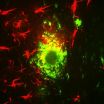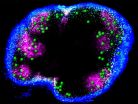(Press-News.org) Montréal, March 31, 2015 - A team of researchers at the IRCM led by Frédéric Charron, PhD, in collaboration with bioengineers at McGill University, uncovered a new kind of synergy in the development of the nervous system, which explains an important mechanism required for neural circuits to form properly. Their breakthrough, published today in the scientific journal PLoS Biology, could eventually help develop tools to repair nerve cells following injuries to the nervous system (such as the brain and spinal cord).
Researchers in Dr. Charron's laboratory study neurons, the nerve cells that make up the central nervous system, as well as their long extensions known as axons. During development, axons must follow specific paths in the nervous system in order to properly form neural circuits and allow neurons to communicate with one another. IRCM researchers are studying a process called axon guidance to better understand how axons manage to follow the correct paths.
"To reach their target, growing axons rely on molecules known as guidance cues, which instruct them on which direction to take by repelling or attracting them to their destination," explains Dr. Charron, Director of the Molecular Biology of Neural Development research unit at the IRCM.
Over the past few decades, the scientific community has struggled to understand why more than one guidance cue would be necessary for axons to reach the proper target. In this paper, IRCM scientists uncovered how axons use information from multiple guidance cues to make their pathfinding decisions. To do so, they studied the relative change in concentration of guidance cues in the neuron's environment, which is referred to as the steepness of the gradient.
"We found that the steepness of the gradient is a critical factor for axon guidance; the steeper the gradient, the better the axons respond to guidance cues," says Tyler F.W. Sloan, PhD student in Dr. Charron's laboratory and first author of the study. "In addition, we showed that the gradient of one guidance cue may not be steep enough to orient axons. In those instances, we revealed that a combination of guidance cues can behave in synergy with one another to help the axon interpret the gradient's direction."
In collaboration with the Program in Neuroengineering at McGill University, Dr. Charron's team developed an innovative technique to recreate the concentration gradients of guidance cues in vitro, that is to say they can study the developing axons outside their biological context.
"This new method provides us with several benefits when compared to previous techniques, and allows us to simulate more realistic conditions encountered in developing embryos, conduct longer-term experiments to observe the entire process of axon guidance, and obtain extremely useful quantitative data," adds Sloan. "It combines knowledge from the field of microfluidics, which uses fluids at a microscopic scale to miniaturize biological experiments, with the cellular, biological and molecular studies we conduct in laboratories."
"This is true multidisciplinary work, and an excellent example of what the Program in Neuroengineering aims to accomplish in situations where neurobiologists like myself have a specific question they want to address, but the current tools aren't adapted to answer their question," mentions Dr. Charron. "Thus, thanks to this unique program, we teamed up with McGill's bioengineers and microfluidic and mathematical modelling experts to create the device required for our study."
"This scientific breakthrough could bring us closer to repairing damaged nerve cells following injuries to the central nervous system," states Dr. Charron. "A better understanding of the mechanisms involved in axon guidance will offer new possibilities for developing techniques to treat lesions resulting from spinal cord injuries, and possibly even neurodegenerative diseases."
Injuries to the central nervous system affect thousands of Canadians every year and can lead to lifelong disabilities. Most often caused by an accident, stroke or disease, these injuries are currently very difficult to repair. Research is therefore required for the development of new tools to repair damage to the central nervous system.
INFORMATION:
About the research project
The IRCM's research project was supported by grants from the Canadian Institutes of Health Research, the NSERC-Create: Training Program in Neuroengineering, the Fonds de recherche du Québec - Santé and the Canada Foundation for Innovation. Other authors include Patricia T. Yam from the IRCM, as well as Mohammad A. Qasaimeh and David Juncker from McGill University. For more information, please refer to the article summary published online by PLoS Biology: http://journals.plos.org/plosbiology/article?id=10.1371/journal.pbio.1002119.
About Frédéric Charron
Frédéric Charron obtained his PhD in experimental medicine from McGill University. He is an Associate IRCM Research Professor and Director of the Molecular Biology of Neural Development research unit. Dr. Charron is Associate Research Professor in the Department of Medicine (accreditation in molecular biology) and Adjunct Member in the Department of Neuroscience at Université de Montréal. He is also Adjunct Professor in the Department of Medicine (Division of Experimental Medicine), the Department of Biology, and the Department of Anatomy and Cell Biology at McGill University. In addition, he is a member of the McGill Integrated Program in Neuroscience and the NSERC-CREATE Training Program in Neuroengineering. Dr. Charron is a Senior Research Scholar from the Fonds de recherche du Québec - Santé. For more information, visit http://www.ircm.qc.ca/charronlab.
About the IRCM
The IRCM is a renowned biomedical research institute located in the heart of Montréal's university district. Founded in 1967, it is currently comprised of 35 research units and four specialized research clinics (cholesterol, cystic fibrosis, diabetes and obesity, hypertension). The IRCM is affiliated with the Université de Montréal, and the IRCM Clinic is associated to the Centre hospitalier de l'Université de Montréal (CHUM). It also maintains a long-standing association with McGill University. The IRCM is funded by the Quebec ministry of Economy, Innovation and Export Trade (Ministère de l'Économie, de l'Innovation et des Exportations).
(SACRAMENTO, Calif.) -- Researchers at UC Davis have illuminated an important distinction between mice and humans: how human livers heal. The difference centers on a protein called PPARα, which activates liver regeneration. Normally, mouse PPARα is far more active and efficient than the human form, allowing mice to quickly regenerate damaged livers. However, the research shows that protein fibroblast growth factor 21 (FGF21) can boost the regenerative effects of human PPARα. The findings suggest that the molecule could offer significant therapeutic benefits ...
Memory and as well as connections between brain cells were restored in mice with a model of Alzheimer's given an experimental cancer drug, Yale School of Medicine researchers reported in the journal Annals of Neurology.
The drug, AZD05030, developed by Astra Zeneca proved disappointing in treating solid tumors but appears to block damage triggered during the formation of amyloid-beta plaques, a hallmark of Alzheimer's disease. The new study, funded by an innovative National Institutes of Health (NIH) program to test failed drugs on different diseases, has led to the launch ...
Study the label of almost any food product and you're likely to see the rather vague warning "May contain peanuts" somewhere on there, unless of course it's a product that definitely does contain peanuts. As now revealed in a paper in the latest issue of JNIRS--Journal of Near Infrared Spectroscopy, these warnings of peanut contamination could soon lose much of their uncertainty, thanks to a novel form of near infrared (NIR) spectroscopy known as NIR hyperspectral imaging (HSI).
Any food product may contain traces of peanut if it is made with powdered foodstuffs like ...
March 31, 2015 - For chronically ill patients with major depression, an approach to cognitive-behavioral therapy (CBT) that incorporates patients' religious beliefs is at least as effective as conventional CBT, suggests a study in the April issue of The Journal of Nervous and Mental Disease. The journal is published by Wolters Kluwer.
"Integrating religious clients' beliefs into CBT does not appear to significantly reduce its effectiveness, especially in religious clients," write Dr Harold Koenig of Duke University Medical Center, Durham, N.C., and colleagues. They ...
Research by Johns Hopkins scientists suggests that having a short series of phone conversations with trained counselors can substantially boost recovery and reduce pain in patients after spinal surgery.
The phone calls, designed to enrich standard pre- and post-operative care by reinforcing the value of sticking with physical therapy and back-strengthening exercise regimens, are a relatively inexpensive and simple intervention that can maximize surgical outcomes for the hundreds of thousands of Americans who undergo spinal surgeries every year, the investigators say.
A ...
Lung diseases like emphysema and pulmonary fibrosis are common among people with malfunctioning telomeres, the "caps" or ends of chromosomes. Now, researchers from Johns Hopkins say they have discovered what goes wrong and why.
Mary Armanios, M.D., an associate professor of oncology at the Johns Hopkins University School of Medicine., and her colleagues report that some stem cells vital to lung cell oxygenation undergo premature aging -- and stop dividing and proliferating -- when their telomeres are defective. The stem cells are those in the alveoli, the tiny air exchange ...
Increasing state alcohol taxes could prevent thousands of deaths a year from car crashes, say University of Florida Health researchers, who found alcohol-related motor vehicle crashes decreased after taxes on beer, wine and spirits went up in Illinois.
A team of UF Health researchers discovered that fatal alcohol-related car crashes in Illinois declined 26 percent after a 2009 increase in alcohol tax. The decrease was even more marked for young people, at 37 percent.
The reduction was similar for crashes involving alcohol-impaired drivers and extremely drunken drivers, ...
Soil organic matter, long thought to be a semi-permanent storehouse for ancient carbon, may be much more vulnerable to climate change than previously thought.
Plants direct between 40 percent and 60 percent of photosynthetically fixed carbon to their roots and much of this carbon is secreted and then taken up by root-associated soil microorganisms. Elevated carbon dioxide (CO2) concentrations in the atmosphere are projected to increase the quantity and alter the composition of root secretions released into the soil.
In new research in the March 30 edition of the journal, ...
CAMBRIDGE, Mass--Sitting in traffic during rush hour is not just frustrating for drivers; it also adds unnecessary greenhouse gas emissions to the atmosphere.
Now a study by researchers at MIT could lead to better ways of programming a city's stoplights to reduce delays, improve efficiency, and reduce emissions.
The new findings are reported in a pair of papers by assistant professor of civil and environmental engineering Carolina Osorio and alumna Kanchana Nanduri SM '13, published in the journals Transportation Science and Transportation Research: Part B. In these ...
Australian scientists have discovered a new population of 'memory' immune cells, throwing light on what the body does when it sees a microbe for the second time. This insight, and others like it, will enable the development of more targeted and effective vaccines.
Two of the key players in our immune systems are white blood cells known as 'T cells' and 'B cells'. B cells make antibodies, and T cells either help B cells make antibodies, or else kill invading microbes. B cells and killer T cells are known to leave behind 'memory' cells to patrol the body, after they have ...

